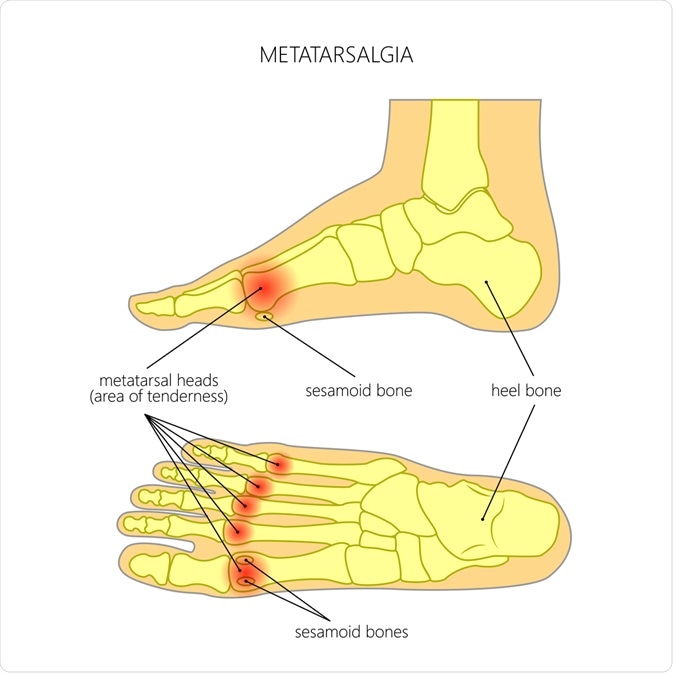The precise management plan for metatarsalgia will depend upon the suspected cause of the symptoms and appropriate responses. Naturally, the likely offender should be avoided during the rehabilitation and recovery phase as the patient builds up the strength in their feet to prevent a subsequent injury. This may involve ceasing participation in intense sport, losing excess weight or avoiding wearing ill-fitting shoes.

Image Credit: Aksanaku / Shutterstock
Physical Rehabilitation
Both a physiotherapist and an occupational therapist may be involved in the rehabilitation process to regain physical strength and ability to participate in normal daily activities.
In the acute phase, the first step to managing the pain resulting from metatarsalgia is the RICE protocol, which involves:
- Rest: avoid weight-bearing activity that may aggravate the foot pain
- Ice: use cold therapy to prevent swelling and inflammation in the area
- Compression: wrap or bandage the area to reduce inflammation
- Elevation: keep the foot elevated to reduce inflammation
After at least 24 hours to allow the body to recover, simple movement exercises can be introduced to improve the strength, function range-of-motion of the foot. It is important that these exercises are continued throughout the healing process to enable the muscles and joints to heal correctly.
Other physical rehabilitation methods may include ultrasound treatments, metatarsal pads and other orthotic devices to provide relief from the pain.
Simple analgesic medications such as paracetamol or NSAIDs (non-steroidal anti-inflammatory drugs) can be used to relieve the pain in the initial stages of the rehabilitation phase.
Surgical Intervention
In some cases, the metatarsalgia pain does not seem to be successfully managed with physical therapy alone and surgical techniques may be required.
An oblique osteotomy is one procedure that has been linked to positive outcomes to address metatarsal pain. This is most useful when there is a structural abnormality of the metatarsal, which can be repositioned with surgical techniques to improve symptoms.
Other surgical techniques that may sometimes be practiced include synovectomy, arthroplasty, wedge osteotomy, ligamentous release and tendon transfer.
Recovery and Maintenance Phase
Following the acute pain period, a patient affected by metatarsalgia should make the progression back to higher intensity activity gradually to allow the muscles and joints to heal and strengthen without causing further damage. The aim of this phase is to restore the normal biomechanics of the foot and relieve the pressure and pain.
Throughout this phase, the patient should work through various exercises to increase strength, stability and range of motion of the feet devised by a physiotherapist.
This phase can be difficult to maintain, particularly for professional or highly motivated sportspeople that wish to continue partaking in strenuous activity as soon as possible. It is important that the patient-physician relationship is strong to ensure that patients understand that their body needs a period of less intense exercise to build up the strength to participate in intensive sports once again.
It can help for patients to substitute intense weight-bearing exercise for other physical activity that is less likely to cause damage to the metatarsals, such as swimming. This is useful to maintain physical conditioning, while simultaneously improving muscular strength.
Over a period of several weeks or months, depending on the severity of symptoms, the patient can gradually begin to recommence physical activity once again. This should be reintroduced gradually to allow the muscles to readjust the physical demands and build up strength to prevent a successive injury. The physical therapy exercises should often be continued indefinitely to maintain strength in the feet.
References
Further Reading